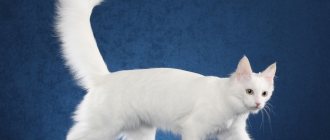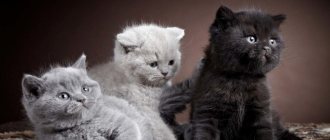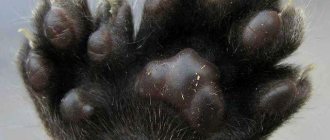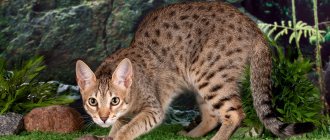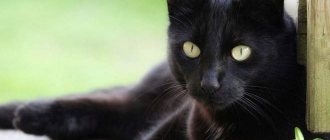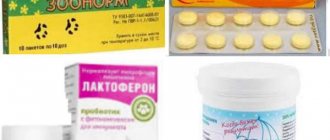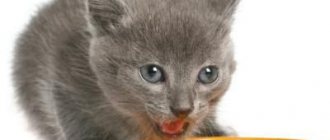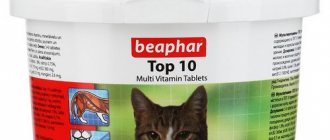Disadvantages of the breed
The appearance of the British cat, described in the standard, is unusually harmonious, so it is very important that all the animal’s features are as close to the standard as possible. Anything that does not fit into the correct description introduces dissonance into the appearance of the animal and spoils the impression of its perception. Therefore, a very important part of breeding work is to obtain an animal that is harmonious in all respects. This is very difficult, especially when working on unusual colors, both because of the small number of quality breeding sires and because of the inevitable influx of blood from other breeds to achieve the desired result. I would also like to note that in addition to the main shortcomings, which will be discussed below, there are countless transitional and more smoothed forms.
Possible disadvantages in type
General impression: according to the standard, the British body should be compact, deep, with short powerful legs. Often there is a stretched body, as well as a lightness of the body on tall thin legs.
Important! The use of the term "thin" applies exclusively to the ideal legs of a Briton, and not to cats in general. The British have very powerful limbs, and even some thinness of individual representatives of the breed cannot be compared with the long limbs of, say, the Siamese breed. The same applies to the consideration of other shortcomings - all the terms used are relevant only in comparison with a good British cat, and not with any other cat.
Wool:
It’s quite difficult to show the imperfections of wool in a picture, so I’ll make do with a text description.
- The characteristic plush coat should be of the correct texture throughout the animal's body, while it is quite common to see longer, close-fitting hair along the spine, and especially closer to the tail. Unfortunately, most Russian British, and even those obtained on the basis of export producers, suffer from this drawback.
- Another, no less common fault is poor coat. Some colors, such as chocolate, are particularly prone to this defect. In general, wool of different colors has its own characteristics - blue wool looks the most correct, close to it is lilac and cream, i.e. light plain wool. Chocolate, as I already mentioned, can be thin and poor-haired, white can have a dry texture and is not elastic enough, black can be too dense and silky. Also, all kinds of tabby colors suffer from insufficiently padded undercoat.
Important!
All these shortcomings relate exclusively to the texture of the coat, while there may be many more possible shortcomings, but they are related to color and require separate consideration.
Tail:
it should be short, thick, tapering to a rounded tip, a kind of pole. But, often, the tail is too long for a given breed, and thin, not well dressed, or noticeably tapering towards the tip.
Head
: the largest number of possible flaws is concentrated on the head, because in addition to the general correct form, there is a standard (and, naturally, deviations from it) for the cheeks, nose, eyes, ears, forehead. Although the standard considers these parameters separately, in fact, correct eye placement is directly related to the length and width of the nose, as well as the shape of the muzzle, i.e. They are interconnected, which means they should be considered as a whole.
The most common shortcomings of British heads
| The so-called pinching. The whiskers (muscles) are too pronounced and do not form a single smooth shape with the cheekbones. | |
| Cheeks are not full enough. Even with other parameters corresponding to the standard, the main charm of the British man disappears - his thick plush cheeks, due to which he looks like a bear cub or a hamster. | |
| “Exotic” muzzle - a shortened and upturned nose is combined with too deep a transition from the forehead to the nose. There is a small hump on the nose, i.e. short nose is NOT straight. In addition, due to the fact that the cheekbones are raised and the nose is shortened, the inner corners of the eyes also rise, which changes the set of the eyes, it becomes more “Persian”. Nasolabial folds are indicated due to insufficiently filled cheekbones (Persians and exotics have a flattened muzzle). In addition, with such a muzzle, the upper part of the head is too convex and the front part of the forehead is flat, and overbites often occur. | |
| “Simplified” type of muzzle, i.e. close to domestic cats. In profile, one can see a flattened forehead, overhanging brow ridges, a sharp transition to the nose and an elongated nose. Viewed from the front, it can be seen that the long nose pushes the ear pads forward behind it, which makes the muzzle non-round, smooth lines, and gives it a box-shaped shape. A more elongated muzzle and elongated nose cause the inner corners of the eyes to droop downward, causing the eyes to appear slanted. Even with full cheeks, with this type of muzzle there is a feeling of disharmony, the muzzle is separate - the cheeks are separate. | |
| The Fox Face type is often found in British Chinchillas. It is characterized by insufficient fullness of the muzzle and a rounded dorsum of the nose and, as a result, a narrowed nasal mirror. A narrowed and elongated nose entails a closer set of eyes, that is, they turn out not only slightly slanted, but also more closely set. This type of muzzle is combined with a weak chin, and underbites are possible. |
A few more comparative angles
Chin
To understand what the chin should be like, you need to mentally fit the muzzle into the oval. A strong, regularly shaped chin will create a single smooth line with the whiskers, without disturbing it.
Profiles
Bite
In breeding and show cats, a scissor bite is considered the norm, when the lower canines fit tightly into the interdental space between the third upper (lateral) incisor and the upper canine, and the upper incisors fit tightly onto the lower ones. Also the norm is a pincer bite (in which the incisors close together straight), and an underbite or overbite of less than 2mm is also allowed.
How is an incorrect bite formed? The fact is that as a result of selective selection, the upper part of the skull is susceptible to stronger changes; it is more plastic than the lower part, because It has connective and cartilaginous tissues and is easier to shorten or lengthen, depending on what is most desirable according to the standard of a particular breed. Therefore, breeds with a round skull and a short muzzle, which include the British, always have a tendency to overshot, and breeds with an elongated muzzle tend to underbite.
Source // www.softcat.ru/standard.html Breed standard and disadvantages
(EXPLANATION, COMPARISON WITH OTHER BREEDS AND DISADVANTAGES OF THE BRITISH BREED IN CHARTS)
Have you decided to opt for a British kitten? Do you want to buy an animal that meets all the standards of the British breed and do not want to buy a “pig in a poke”?
Then you definitely need to familiarize yourself with these tables and diagrams. They will clearly explain to you the difference between British cats and any other breeds.
So, let's begin:
HEAD
The experts' closest gaze is directed at the cat's head. Since the most possible defects are concentrated on the head. After all, in addition to the general correct shape, there is a standard for the cheeks, nose, eyes, ears, forehead!!! And even these parameters are considered separately.
Correct eye placement is directly related to the length and width of the nose and the shape of the muzzle, i.e. they are interconnected.
The correct shape of the head of the British breed has smooth outlines from all angles!!
COMPARISON OF BRITISH HEAD AND STRAIGHT
The red lines are identical below, another head is visible in the overlay
As we can see, the head of a British cat is more smoothly outlined and, as it were, rounded.”
The set of the ears - the width between the ears is the same, but the British ears are much wider and at a different angle, while the Straights have a more straight set and at the base too. Exactly this, incorrect for a Briton, but correct for a Scotsman, is the placement of the fold that forms the correct ear.
Noses - the British nose is lowered due to the wider angle of the bridge of the nose in relation to the forehead and the smooth outline of the muzzle, while the Straight has very pronounced mustache pads, this is not suitable for the British. The British man's mustache pads are smooth and soft and create the famous CHESHIRE SMILE.
But the position and shape of the eyes and the distance between them are the same.
In the above figure, for comparison, you can see that the British have fuller cheeks.
In profile you can see that the Briton has a more powerful and shorter neck and a powerful scruff. The British cat's head is set low and enhances the impression of strength and power of the cat. The Fold has a round head set higher on the neck. The fold profile for a Briton would be extreme; according to the standard, the transition from forehead to nose is smooth, but without a stop (without a sharp transition).
THE MOST COMMON DISADVANTAGES OF BRITISH HEADS.
The pinching of the whiskers is too pronounced and does not form a single smooth shape with the cheekbones.
At the top of the picture, the cheeks are not filled out enough. The main charm of the British man disappears - his thick plush cheeks, due to which he looks like a bear cub.
“Exotic” muzzle. Shortened and upturned nose with a deep transition from the forehead to the nose. Short nose, narrowed nose. Due to the fact that the cheekbones are raised and the nose is shortened, the inner corners of the eyes also rise, which changes the position of the eyes. The eyes are not just round, but as if protruding. With such a muzzle, there is a convex upper part of the head and a flat front part of the forehead, and distortions often occur.
“Simplified” type of muzzle i.e. like in domestic cats. In profile you can see a simplified forehead, an overhang of the brow ridge, a sharp transition to the nose and an elongated nose because of this the muzzle is not rounded, but takes on a box-shaped shape. This entails a drooping of the inner corners of the eyes and they stand askew, and take on an oval shape instead of a round one. Even with full cheeks, disharmony is felt. The muzzle is separate, the cheeks are separate.
“Fox face” - often found in British chinchillas, characterized by insufficient fullness of the muzzle, the back of the nose like a pipe, and a narrowed mirror of the nose. A narrowed and elongated nose entails bringing the eyes closer together. This type is combined with a weak chin and the possibility of underbite.
Here are some more perspectives for comparison;
CHIN
To understand what the chin should be like, you need to mentally fit the muzzle into an oval. A strong, regularly shaped chin will create a single smooth line with the whiskers, without disturbing it.
With the correct shape and proportion of the head, ears that do not meet the standard noticeably spoil the impression.
Correct set and shape of the ears in frontal view and
in profile. In profile, the ears have an inclination of 35*
. Correctly shaped and set ears, wide at the base, short with rounded tips and widely spaced on the head.
“Rabbit ears” seem to be turned back, it feels like the cat is listening.
Correctly set, short, but not wide at the base, which makes them look small.
“The ears fall apart” - the correct shape and size, but set low and tilted forward; if the cat is interested, they almost lie horizontally.
“Hare” - Too large, set high. Sometimes they appear. a stable defect, or may be age-related in young cats when the growth of the skull is delayed and the ears have reached adult size. After the skull grows and expands in width, the defect will decrease or disappear altogether.
BITE
In breeding and show cats, a scissor bite is considered the norm.
Breeds with a round skull and a short muzzle (British) have a tendency to overshot, while breeds with a long muzzle have an underbite.
If you do not select for incorrect bites, not only overbites are possible, but also distortions leading to facial asymmetry.
The NOSE
does not taper towards the tip,
it is wide along its entire length. The nose and bridge of the nose are wide. The width of the nasal mirror is the same as the bridge of the nose, there should be no narrowing of the nostril (Persian heritage). The length of the nose is relative to the length of the head.
The distance between the inner corners of the eyes is equal to the length of the nose A = B. A wide bridge of the nose should fit the size of the eye at the level between the eyes.
EYES
large, round, widely set. Pupils at the level of the inner edge of the ears.
BRITISH PHYSIL COMPARISON
The Briton has a large body, on short powerful limbs, a short, thick tail, rounded at the end. In height from the withers to the floor, the body occupies 2/3 and the legs 1/3.
And the Scottish Fold has a lighter constitution, longer limbs and a long tail tapering towards the tip. The body and legs occupy 1/2 of the height from the withers to the floor.
According to the standard, the British body should be compact on short powerful legs (Fig. 1), stretchiness is often encountered (Fig. 2), as well as lightness on high legs (Fig. 3)
All British people with a good powerful squat, but not too overloaded body fit into the proportion of 1.12/1
You have to feel it, the fur hides a lot, for example, a high/low tail set, a sloping croup, and the scapulohumeral angle also plays a role.
TAIL
should be short and thick. tapering to a rounded tip, but sometimes the tail is long and thin, insufficiently dressed, noticeably tapering to the tip.
The tail is of the correct shape and length. Fig. 1.
The tail is too long, noticeably tapering towards the tip. Fig. 2.
These are the show standards of the breed. Cats that meet these parameters have the SHOW class. There are also classes PET (pet) and BREED (for breeding). In these classes, small discrepancies and errors are acceptable, which, however, do not prevent these animals from delighting their owners and living a long and happy life! Don’t forget, there are very few ideal animals and, of course, they are the greatest pride of nurseries!
A cat's nose is a delicate and sensitive organ. A healthy nose does not cause problems for the animal, but sometimes it can become swollen. This is a pathological condition, so every cat owner should know what to do if a cat has a swollen nose.
Why do cats have swollen noses?
Cats are curious animals, so they poke their noses everywhere, exploring the world around them. In this matter, many dangers await them. A cat's nose consists of thin bones and small cartilages, and its mucous membrane is penetrated by a network of nerves and capillaries, so a tumor on a cat's nose can very easily occur after bruises and injuries.
This can be determined by swelling, red or bluish mucous membranes, nosebleeds, or dried blood in the nasal passage. An animal, experiencing pain, worries, refuses food, hides in a secluded place and does not allow itself to be touched. If a cat has broken its face until it bleeds, it is difficult for him to breathe, he sniffles, snorts and sneezes.
The reason why a cat's nose is swollen can also be
:
- Bites and scratches
. Cats fight with each other and with dogs, getting injuries to the nose, as a result of which it becomes very swollen. - Allergic reaction
. The most common types of allergies that cats are susceptible to are flea saliva allergies, atypical dermatitis and food allergies. - Infections
. When immunity decreases in animals, viral, bacterial and fungal diseases develop, one of the symptoms of which is swelling of the eyes and nose and discharge of pus from it. - Polyps on the mucous membrane
. These are tumors that arise due to persistent infections and inflammation of the nasopharynx. With polyps, cats constantly sneeze, sniffle, breathe through their mouths, get nervous, shake their heads, and clear fluid leaks from their nasal passage.
Treatment for swollen nose in cats
A swollen cat's nose requires treatment, which will vary depending on what caused the condition.
Here's what to do if your cat has a nose tumor:
- If blood is flowing from the nasal cavity, pick up the animal and blot the blood with a napkin or piece of gauze moistened with a solution of hydrogen peroxide. Apply cold to the bridge of the nose. Leave it until the blood stops flowing.
- If a cat's nose is swollen from wounds, scratches and bites, then they are carefully smeared with iodine, brilliant green or antiseptic ointments. Treatment continues until complete healing.
- In case of infections and allergic reactions, you should not treat animals yourself, because this can do more harm than good. Treatment of a cat should be entrusted to an experienced veterinarian. He will examine the animal and prescribe the necessary medications. To prevent diseases, you need to show your cat to a doctor at least once a year.
- Polyps in a cat's nasal passage can also only be eliminated by a specialist.
In any case, you cannot ignore a cat whose nose is swollen. With a swollen nose, she suffers, refuses food, loses weight, and may become even more ill, so you need to carefully monitor your pet and provide him with timely help.
“God created the cat so that man would have a tiger that he could pet”
V. Hugo
It is simply impossible to confuse the Oriental cat with any other breed, because it is difficult to find a more graceful and elegant cat, with huge widely spaced ears and a humpbacked profile, like a figurine , is a sophisticated representative of the cat world.
Even the name of the breed translated from English means “eastern”. Shorthaired Oriental, Siamese and Seychelles cats belong to the group of Oriental cats, so they have the same breed standard. What then is the difference between Oriental, Siamese and Seychelles cats, you ask. Oriental, Siamese and Seychelles cat breeds are one and the same. These breeds have an absolutely identical description in the standards of all felinological systems and differ only in color and eye color. There are no other differences, and the character is no exception; it is also very similar in these cats. Of course, we should not forget that each cat has its own unique character traits, just like a person, each cat is a personality, an individual.
How to choose?
When choosing a big-eared kitten, you should focus both on its appearance (many, for example, cannot stand the sight of cats without fur or are not ready to put up with the shedding of a Turkish Angora) and on its character traits. Families with children should be careful when choosing representatives of breeds such as Savannah, as these cats can be very active and even aggressive. The same applies to Siamese cats, in which the “call of the wild ancestors” periodically awakens, and they can, for no apparent reason, bite or rush at a person, even if this is an adored owner.
It is imperative to take into account the size of the cat and relate it to the size of your home. Will an active pet, such as an Abyssinian cat or a Serengeti cat, have the opportunity to run and climb to its heart's content? Will the Havana or Angora have enough horizontal surfaces to allow them to spread out gracefully? Are you ready to keep the windows closed at all times so that your beloved Sphynx does not catch a cold or sneeze? Will you be able to calmly accept the manifestations of the Siamese’s irrepressible temperament?
Think carefully about all the issues before purchasing a kitten, because most of them are not cheap. When buying a pet, make sure that he is comfortable with you, but you should not live in constant restrictions.
You need to find a cat so that both she and you are happy with your life together.
History of the Oriental cat breed
Orientals came to our world from Siam (modern Thailand), so their history is closely connected with the Siamese cat. Ancient manuscripts and frescoes provide evidence of the existence of a similar short-haired breed of different colors. The export of Oriental cats from Siam was banned for a long time, but they still found their way to Europe. They were brought to England at the end of the 19th century, where they won the attention and great love of breeders.
In America, the first Oriental cat appeared in 1956 and two years later a preliminary standard was adopted. American breeders achieved full recognition of the breed only in 1977. The Oriental cat appeared in Russia in 1987.
Today the breed is very popular among a large number of breeders and cat lovers in Russia.
Origin story
There is no clear theory of the origin of this short-tailed breed. Cats with naturally short tails are found in Japan, Russia, and Malaysia.
The ancestors of the Manx may have been accidentally introduced by Spanish colonizers when one of the ships crashed near the island. The ship's cat, the rat catcher, swam to shore and became the founder of a new breed. Long-term isolation and a small number of individuals fixed the main features: a short tail, a rabbit gait and a balanced temperament.
Reference! In England they are so proud of their breed that they issued coins worth one crown with the image of a Manx.
Breed standard
An oriental pussy can be seen from afar - it is the embodiment of grace, the ideal of a cat in general. Here are the outstanding characteristics of the Oriental breed:
- a wedge-shaped muzzle and an elongated nose with a hump.
- a straight line is formed from the tip of the nose to the edge of the chin;
- wedge-shaped, wide, slightly rounded, huge, low-set ears;
- medium-sized almond-shaped eyes;
- elegant, flexible and long body - strong muscles on an elegant bone;
- the stomach is tucked, the body tapers towards the tail;
- thin, flexible and long neck;
- slender limbs with small oval paws;
- elongated, thin, tapering tail;
- short-haired individuals have thin, close-lying short shiny hair without undercoat, of uniform color;
- long-haired - a medium-length fur coat without undercoat, a bushy tail;
There are 42 color options for Orientals, but the basic ones include:
- ebony (black);
- havanna (chocolate);
- lavender (lilac);
- blue (gray);
- cinnamon (brown);
- faun (beige);
- red (red);
- cream (light red).
The color should be equally intense along the entire length of the hair; if the color is tabby, then the pattern should be clearly visible. An Oriental cat usually weighs 3-5 kg, and a male cat can reach up to 6 kg. Disadvantages at exhibitions are considered to be squint or clearly visible cartilage in the chest area.
A little about the character of the Oriental cat
“You can’t be the owner of a cat.
Partnership is the best one can hope for.” Sir Harry Swanson
So, Oriental cats are very active, agile, curious, affectionate and sociable. And they love to communicate, they don’t just meow and purr, they have a lot of different intonations in their arsenal. The cat can quietly talk with the owner, telling in detail how her day went, what she saw and did; be capricious if she is bored or bothered by something, or complain loudly if she is offended or ignored. In general, cats of the Oriental breed have three main differences - an immense love for humans, a constant need to eat and chat.
Every minute, they will entertain their owner with their charisma, their deft jumping, talking about everything in the world, playing with a mouse or a ball, or simply sitting with him in front of the TV. Oriental cats really do not like to be left alone for a long time, so they are ready to hover around a person most of the time. Oriental cats are big fans of traveling; it’s better to be anywhere, most importantly with their owner.
The talkativeness of this breed is, of course, a separate conversation. The owners know absolutely exactly what their beloved cat is talking about, communication with them turns into a real dialogue. Even adult cats are very playful; in this character trait they are similar to dogs. The Oriental is flexible, open and trusting, easy to train, and brings objects.
Cats of this breed love all family members, but they are most devoted to one person, to whom they give their preference, and express their courtesy to him in every possible way. Rest assured, the oriki will meet you from work, take you to wash your hands, and bring you slippers (just kidding, of course). Oriental cats get along well with children and love interactive toys, swings, fishing rods, mice and balls. They don't scratch or bite.
Another inseparable trait from an oric is curiosity. Often it is so large that even the most cowardly Orik will crawl out of the lair to see what is going on “there”. By the way, this is why in their upbringing we often have to remind them that this cannot be done even today. And check the order in your closets, oh, that is, in his closets, of course! Open the door or drawer of the cabinet, in which perhaps something interesting, or maybe even tasty, is hidden... yes, an Orientalist definitely needs this!
There is another trait that is also very characteristic of Orientals - curiosity. They are interested in everyone and everything, stick their nose into everything, nothing can be done without them. Curiosity does not leave the orik even when guests come to the house. They do not hide in cover, like many other cats, but make contact and make absolutely anyone fall in love with them, even those who were very indifferent to cats.
Oriental cats also love the company of other pets, regardless of whether it is a cat, dog or hamster. But still, they achieve the greatest harmony in relationships only with animals of similar temperament and activity, for example, with other orics. After all, there are never too many orientals. And so their ori company grows - first one, then another, and possibly a third.
Another advantage of this wonderful breed is that Orientals are a hypoallergenic cat breed, due to the lack of undercoat, which is a real boon for people suffering from allergies.
Caring for the Oriental cat breed is not difficult, but it has some peculiarities.
— Short-haired animals do not require special coat care - bathe when dirty, use a rubber brush for short-haired cats. — Long-haired dogs need to be brushed once a week - the hair does not tangle due to its medium length and the absence of undercoat. — There are usually 4-6 kittens in a litter, which the mother carefully cares for until 3-4 weeks, without letting them leave the nest. — Kittens of the Oriental breed develop very quickly—the kittens’ eyes open on the 3rd day, and the main thing is to just carefully monitor their development. — The best toys for orientals are hanging fishing rods and balls, soft mice. — The breed’s health is excellent, it is only necessary to maintain it with mandatory preventive procedures. — The Oriental’s diet should be balanced, containing the right amount of proteins, fats, carbohydrates and vitamins. — These cats are quite sensitive to cold, so they need to be protected from drafts.
Health
Oriental cats attract world breeders not only with their magnificent appearance, but also with fairly good health, which is important. There really are no breed-specific diseases in this breed. With proper nutrition, maintenance and care, Orientals live a very long time. But there are two problems - progressive retinal atrophy and flat chest syndrome, which are transmitted genetically.
Progressive retinal atrophy is a hereditary disease in which retinal cells are destroyed, resulting in complete or partial blindness of the animal. The disease can begin both in adulthood and at a young age. As a rule, breeders test animals for genetic diseases in order to produce healthy offspring.
The second genetic disease is flat chest syndrome, a disease that leads to deformation of the chest. It develops only at an early age - in kittens. The close genetic relationship to the Siamese breed suggests a possible risk of inherited diseases such as cardiomyopathy and liver amyloidosis. There is a possibility of dental diseases, feline asthma and upper respiratory tract diseases.
All genetic diseases can be identified before mating of parental pairs, thereby protecting kittens from the risk of severe heredity.
Who is an Oriental cat suitable for? If….
- Have you always dreamed of the perfect cat?
- You have always dreamed of a dog, but did not have the opportunity to have one, because you need to walk the dog.
- You get nervous quite often and sleep lightly.
- You do not have kids.
- You have children of any age.
- You don't like watching TV alone and need a companion.
- You've always had cats, but you dreamed of a dog.
- You have no one to talk to or no one to listen to you, you need an interlocutor.
If you let a magical cat from the Siamese kingdom into your home, you will get an unusually graceful, affectionate and intelligent animal that will be loving and devoted, ready to prove it to you with its huge little heart again and again.
God created the cat. Oriental cat breed
For cats, as well as for other animals, smell is one of the most important senses, even despite the cat's famous vision. After all, you may not see the prey, but you can smell it. By smell you can find out if someone was on their territory, and who exactly it was. By and large, smell can be considered the second sight of animals, it plays such an important role in their lives.
Karelian Bobtail
This breed got its name because of the place where it was first discovered; they come from the Karelian Isthmus. Initially, it was believed that the Karelian bobtail and the Kurilian were relatives, but later it was found out that these species are not genetically related, but it is worth noting that their appearance is similar.
The standard for this breed was approved in 1990. There are few purebred representatives today. The Karelian Bobtail can be short-haired or long-haired, gains up to 6 kg, and lives on average up to 10-15 years. They tolerate cold and heat well. Like Kuril Bobtails, these cats are very smart, obedient and affectionate, but this breed values its own space more and prefers peace and solitude. It is precisely because of their balanced, patient nature that they can be safely left with the child.
These cats also get along easily with other animals; in favorable situations, they even get along calmly with dogs. If you hear a Karelian Bobtail trying to attract attention to something, you are more likely to mistake its call for a purr rather than a meow.
Smell is everything to a cat
It all starts from the very first days of life. After all, newborn kittens are completely blind. How then do they unmistakably find the mother cat’s milk nipples? Of course, by smell. By smell, the mother cat herself distinguishes kittens from the same litter, and the kittens themselves distinguish each other and all surrounding objects.
Cats mark their territory using special odorous liquids that are secreted by glands on their faces and near their tails. This is why cats often rub their faces against objects. Including the owners, they also mark them as something that is located on their territory and is their property.
Cats find a cat that is ready to mate by smell, and cats find the cat that is most suitable for them. The smell also identifies whose territory the cat is currently in, or whether a stranger is present in his own possessions.
Parting with familiar smells causes quite a lot of stress in a cat. That’s why your pets have such a hard time going through moving, buying new furniture, and especially renovations. After all, if when moving or buying a new sofa the smells remain more or less natural, then during renovation the smells of paints and other building materials can simply drive the poor animal crazy. Therefore, during the period of reconstruction, it is better to take the cat to the dacha or to another house.
It should be noted that the shape of cat noses depends on the breed. It is clear that the nose of a Siamese or Siberian cat will be much larger than the nose of a Persian. And the hump nose of a Burmese cat can be safely described as aristocratic or “Roman”.
Kitten price and nurseries
Buying a Manx in Russia is almost an impossible task, because there are no official nurseries of the Manx breed in the country. With due persistence, you can buy a Manx kitten in nurseries in the UK, Ireland, USA and Canada. The average price of a Manx is 30 thousand rubles for a pet class kitten.
When purchasing, pay attention to the kitten's parents. The main rule is that only one parent can be completely tailless (rampi). Crossing cats without tails can lead to serious spinal diseases in the offspring. Kittens with Manx syndrome rarely live past 4 months.
Only tailless individuals participate in exhibitions, and tailed Manxes participate in breeding work.
Cat nose device
A cat's nose, like a human's, consists of two nasal canals separated by cartilage. When a cat inhales air, it enters special nasal chambers. There he passes through winding channels, lingering in them for some time. During this retention of air in these channels, odors are recognized.
The cells responsible for recognition are bottle-shaped and end in several sensory hairs. And the hairs are covered with mucus, in which all odorous substances dissolve. These analyzer cells are directly connected to the part of the cat's brain responsible for smell.
In addition to the analytical function, the nasal sinuses also perform a kind of filter and air conditioning function. The air passing through them is heated and cleaned of dust and bacteria.
To sniff unfamiliar objects, cats use a specific organ called the Jacobson tube. This tube can simultaneously identify not only smell, but also taste. This organ is located above the upper palate. The cat uses it when it inhales air through its mouth.
This lifts the upper lip and exposes the incisors. Perhaps you could observe this in your pet and remember this rather funny grimace, vaguely reminiscent of a grin.
Although a cat's sense of smell does not reach that of a dog's, it is definitely many times better than a human's. Therefore, your pets can react quite painfully to many odors. Which, by the way, you won’t even feel.
Therefore, you should not wash your cat's bowl with dishwashing detergent. Because what is a barely perceptible pleasant smell for us is something akin to a gas attack for cats. And even if you use detergent, try to rinse out any remaining detergent from the bowl as thoroughly as possible.
Agree, it will be unpleasant for you if someone pours a bottle of perfume into your food. So the cat is unpleasant to the extra odors present in its food and completely suppressing its appetite.
Also, the nose is a kind of indicator of health. Have you heard the expression “a wet nose is a healthy dog”? This also applies to cats. In a healthy animal, the nose should be cool and moist. Humidity is provided with the help of a special secretion and during licking.
In addition, maintaining body temperature at an optimal level also occurs through the nose and oral cavity. After all, cats only sweat the pads on their paws, and this is too little for full heat exchange.
